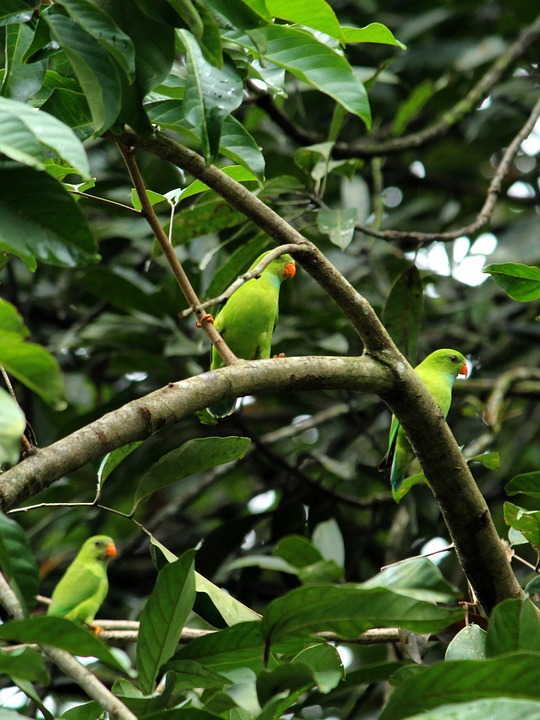**Header: How to Encourage Parrots to Participate in Trick Demonstrations**
**Introduction**
Parrots are highly intelligent and social creatures that thrive on mental stimulation and interaction. Teaching them tricks not only strengthens the bond between you and your feathered friend but also provides valuable mental exercise. However, getting your parrot to participate in trick demonstrations can be a challenge. This article will guide you through effective techniques to encourage your parrot’s participation, ensuring a successful and enjoyable training experience.
**1. Building Trust and Positive Reinforcement**
– Establishing a Bond: Strengthening the bond with your parrot is crucial for successful training. Spend quality time together, engage in gentle interactions, and create a loving and trusting environment.
– Positive Reinforcement: Reward-based training is the key to encouraging parrot participation. Use treats, praise, or favorite toys as rewards for desired behaviors. Positive reinforcement motivates parrots to repeat those behaviors in trick demonstrations.
**2. Setting Up a Training Area**
– Quiet and Distraction-Free Space: Choose a designated area for training where your parrot can focus without distractions. Turn off loud noises, TVs, and radios to create a calm environment.
– Proper Lighting: Ensure the training area is well-lit, as parrots respond better to visual cues. Avoid dimly lit areas that may hinder their ability to see and understand commands.
**3. Starting with Simple Tricks**
– Step-by-Step Approach: Begin with simple tricks that your parrot can easily grasp. Teach them one trick at a time, breaking it down into smaller achievable steps. This approach helps maintain your parrot’s motivation and prevents frustration.
– Basic Tricks to Start With: Some simple tricks to begin with include “step-up,” “wave,” or “turn around.” These tricks provide a solid foundation for more complex behaviors later on.
**4. Consistency and Repetition**
– Consistent Training Schedule: Establish a regular training schedule that suits both you and your parrot. Consistency is key to reinforcing learned behaviors and maintaining progress.
– Repetition: Practice each trick consistently, repeating the training sessions several times a day. Gradually increase the difficulty level as your parrot becomes more proficient. Remember, patience is essential throughout the training process.
**5. Making Training Fun and Engaging**
– Short and Positive Sessions: Keep training sessions short to maintain your parrot’s interest. Aim for 5-10 minutes per session, focusing on positive reinforcement and ending on a high note.
– Incorporating Play: Integrate play into training sessions to make them more enjoyable. Use favorite toys or incorporate interactive games that align with the trick being taught. This approach keeps your parrot mentally stimulated and eager to participate.
**FAQs**
**Q: My parrot seems uninterested in participating. What should I do?**
A: If your parrot appears uninterested, review your training techniques and ensure you’re using positive reinforcement. Adjust the reward system if necessary and consider trying different tricks that align with your parrot’s natural inclinations.
**Q: How long does it take to train a parrot for trick demonstrations?**
A: The training duration varies depending on the parrot’s individual personality, previous training experience, and the complexity of the trick. Some parrots may learn quickly within a few weeks, while others may take several months. Remember, consistency and patience are key.
**Q: Can older parrots learn new tricks?**
A: Absolutely! Parrots of all ages can learn new tricks. However, older parrots may take longer to adapt to new behaviors due to established habits. Patience and persistence are crucial when training older parrots.
**Q: Are there any tricks that parrots cannot learn?**
A: Parrots are capable of learning a wide range of tricks, but it’s important to consider their physical limitations and natural instincts. Avoid tricks that may be harmful or stressful for your parrot, such as forcing them into unnatural positions or performing dangerous stunts.
**Conclusion**
Encouraging parrots to participate in trick demonstrations requires patience, positive reinforcement, and a trusting bond. By following the techniques outlined in this article, you can create an engaging training environment that stimulates your parrot’s mind and strengthens your relationship. Remember, every parrot is unique, so adapt your training techniques to suit their individual needs and abilities. Enjoy the journey of teaching your parrot new tricks and relish in the joy of their accomplishments.









